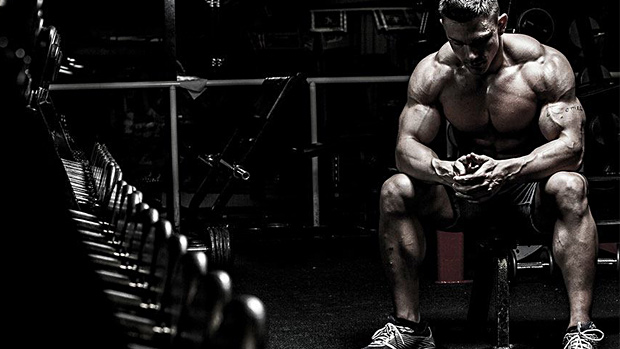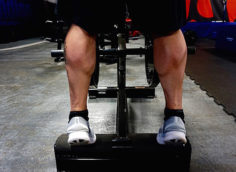One-Arm Deadlift: ROM + Overload
Powerlifters deadlift for obvious reasons, but bodybuilders love the deadlift too, especially for adding slabs of muscle to the upper back, traps, and lats. To really nail the upper back, many bodybuilders prefer rack pulls: starting the bar on supports so the pull begins around knee height.

Rack pulls isolate the back better by taking the legs partly out of the equation. And you can go really heavy, usually 100-plus pounds more than when doing the standard deadlift. The main difference between the rack pull and the deadlift is the range of motion. It becomes an exchange of range of motion for overload.
But what if you could have it both ways – getting the range of motion of a deadlift and the overload of a rack pull? You can with the one-arm barbell deadlift.
With the one-arm deadlift, more tension can be experienced by the upper back because you'll have almost twice the reserve power coming from the legs. What? How? Well, if you're using one arm, you'll need to back off the weight significantly, but don't panic about that.
In relation to the traps, rhomboids, and lats, a 250-pound one-arm deadlift is the same as a 500-pound deadlift done with both hands. In fact it's even better. You may find yourself able to perform more reps with the one-arm deadlift than you would with both arms.
And if you do it right, the activation of the lats and range of motion is greater. If you didn't feel your lats before on a regular deadlift, you will when doing these.
The traditional rules of deadlifting still apply.
- Keep the bar in front like you would during a normal deadlift, not to the side like a suitcase deadlift.
- Use your strongest stance (conventional or sumo) but grab the bar in the middle with one hand. Start off light to get the feel for it. You may need to move slightly to one side to take advantage of your stronger fingers, and it may differ from left to right.
- Keep the abs tight and tense the lat of the working side before lifting up.
- Your hand starts from the center midline of the body. As you rise up, allow it to float to your side.
- Don't allow your body to twist to a favoring side. Your torso should be as un-rotated as it would be during a conventional deadlift. Keep the bar as steady as possible on the way up.
- Finish through by locking out the glutes.
- Don't haphazardly drop the weight! The bar should be as steady on the decent as during the ascent. This will dictate the speed you should be using.
Ramp up as high as you can to build grip strength and coordination. Don't use straps until you need to.
A Little Precaution
Take at least 30 seconds rest between working each side. It's a unilateral exercise but your abs and legs will work during every set. Don't get fatigued and let your reps get sloppy. And don't use a belt. Just don't. Belts are for holding up pants. Get good and improve your core strength.
- Use it as an activation exercise. You can use the one-arm deadlift with lighter weight before doing your regular deadlifts if you have trouble recruiting the lats during the movement.
- Use it in a continuous ramp. Start with ramping up with the one-arm deadlift and proceed to RDL, then sumo, then conventional.
- Use it on a deload week. Take a break from heavy squats, deadlifts and other spinal compressing exercises. Keep the reps between 3 to 6.
The Right Reps
The biggest problem I see among gym bros is that they use this exercise solely as an attention-getting circus act and not as an intelligent application of training. Use 3 reps for building strength and 6 reps for building size. More than 6 reps hits the cardiovascular system and this isn't meant for that.
A Sample Plan
Ramp up to a 6 rep max, then do 3-4 working sets at that weight. At 6 reps it's still heavy but doesn't overstress the nervous system. This keeps it out of the 90% zone and allows you to keep the exercise in rotation longer. The ramp also helps slowly build grip strength and allows you to autoregulate when it comes to the weight you should be using that day.
Sample Ramp-Up Sets
- 95 pounds x 6 reps
- 135 x 6 reps
- 185 x 6 reps
Working Sets
- 225 x 6 reps
- 225 x 6 reps
- 225 x 6 reps





